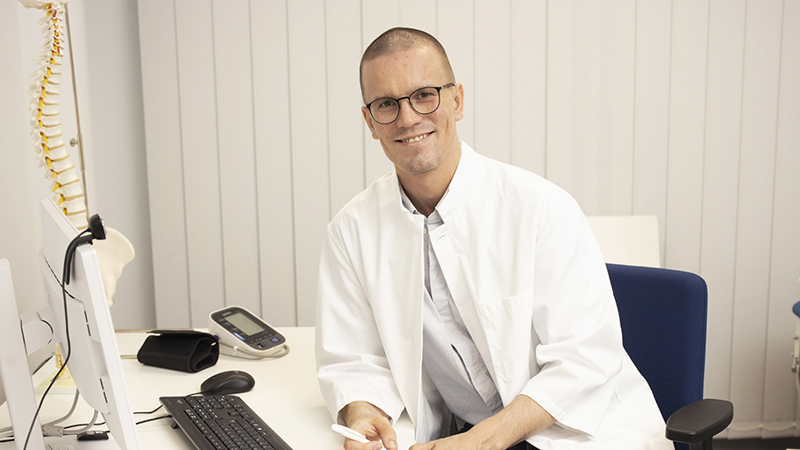Musculoskeletal disorders absenteeism down 13% in 2022 - What finally made the ship turn around?

I remember well a drawing I made in my notebook during my specialisation. I drew a stick figure running along the line; a stick occupational physiotherapist. The line I drew depicted the transformation of occupational health and working life over the last couple of hundred years; from the industrial revolution, the early days of occupational health and factory doctors, to the Occupational Health Act of the 21st century and the large teams of occupational health specialists. While occupational health had developed by leaps and bounds along the way, our working lives and environments had changed even more rapidly. Despite the leaps and bounds, the stick occupational physiotherapist was still constantly one step behind, often only involved when the problem had already arisen. I wrote the question under my drawing; when will occupational health get to the point where we walk alongside the workplace and see what is coming, so we can prevent it? My stick occupational physiotherapist had to wait a good decade for that answer...

2022 was a year of change for musculoskeletal issues. The reform of the Occupational Health Act provided an opportunity to strengthen the timeliness of intervention for musculoskeletal symptoms and promote work capacity management. At the same time, a significant reduction in absenteeism due to musculoskeletal issues was seen.
Does this mean that the big ship has finally turned? To understand better, we need to look at the stern for a moment.
In the early 2000s, the occupational health team was made up of occupational health professionals: occupational doctors and nurses. They were also supported by a wide range of occupational health specialists; occupational physiotherapists, occupational psychologists, social workers and nutritionists. The whole of occupational health, its content and the coil allowances that governed its activities, was based on an initial assessment of the needs of the professionals. For example, the use of an occupational physiotherapist in occupational health was always subject to a referral or mandate from a doctor or nurse. While this was well thought out and controlled, it created an unintended bottleneck that often delayed access to treatment.
Over the years, statistics revealed that occupational physiotherapists were increasingly under-utilised in preventive occupational health activities such as workplace screening and health checks. Most of the activities took place in the reception rooms - unfortunately only at the stage when the client already had a musculoskeletal problem. For a long time, sickness absence related to musculoskeletal issues was on a steady upward trend, as was the cost of occupational health, but the use of occupational physiotherapists was decreasing. The ship had to be turned around and soon.
The first big gamble to turn the musculoskeletal ship around was the introduction of direct access to physiotherapy in occupational health. In a direct appointment, a specially trained occupational physiotherapist or physiotherapist could not only assess the condition and treatment plan, but also assess fitness for work and advise on the use of over-the-counter painkillers. An extremely good and effective treatment pathway, but one that we did not know how to go to, because for years we had been conditioned to think that treatment always starts with a doctor's appointment. In companies, employees simply did not yet know that direct access existed, or when to go there.
The Covid-19 pandemic that started in 2020 also affected the health of musculoskeletal in a number of ways. Many people started to work in a hybrid model and faced new challenges in terms of work ergonomics as work patterns, working spaces and habits changed. At the same time, the physical activity levels of the Finnish population became polarised; some people became more physically active, while others lost even a small amount of physical activity. Finally, at the beginning of 2022, the revised Occupational Health Care Act came into force, and the opportunities it brought with it came at a crucial time. The amendment returned occupational physiotherapists to the status of occupational health professionals, enabling timely and effective work on musculoskeletal cases.
At Terveystalo, we boldly reformed our occupational health processes and strengthened the role of the occupational physiotherapist as the lead expert in the occupational health team for musculoskeletal cases. We increased the responsibility of the occupational physiotherapist in workplace screening, especially in areas with physical stress, and in certain situations even in a lead role in the team. For those working in physically demanding sectors, we also created targeted health screening activities at the occupational physiotherapist's surgery, to identify at the earliest possible stage those whose functional capacity and job demands are in conflict. In this way, everyone's ability to work can be supported from the start of their career.
We also changed the division of responsibilities in work capacity management, so that at Terveystalo, responding to the 30-day musculoskeletal sickness absence accumulation is now on the occupational physiotherapist's to-do list. In addition to these measures, the timeliness of the musculoskeletal care pathway was facilitated by the introduction of a referral-free status, which removed bottlenecks and speeded up access to the care pathway. The change was significant and expectations were high.
I anticipate that the reforms we made thanks to law renewal would change the approach from reactive to preventive and from individual to workplace. This is exactly what happened, and the change was already visible in the spring of 2022. The longer-term goal was to increase the effectiveness of the intervention by accelerating access to the right care pathway and the timeliness of care. This change in trend is also visible in the sickness absence statistics for 2022.
What's next?
After a promising period of change, it is time to push the acceleration pedal so that in the coming years we can also see a downward trend in long-term sickness absence and disability pensions. This will require teamwork and commitment to a common agenda. In addition to teamwork, the key to success is to raise employees' awareness of musculoskeletal models and care pathways in occupational health, so that they understand their own opportunities to influence their own health and ability to work. So let us move as one team, occupational health, employers and workers, towards a better future.
Although my stick-work physiotherapist is clearly smiling and venting at this stage, the musculoskeletal issue is only the first step, as we have an equally big challenge on our hands from a mental health perspective. I, for one, am fully committed, excited and motivated to equally boldly revolutionise the mental health field to support work capacity. Together.

Janina is Terveystalo's leading senior occupational physiotherapist who fights for musculoskeletal health in Terveystalo's great occupational health team.
Read more blogs

Together towards a healthier workplace: The power of occupational health partnership
A healthy workplace is the result of collective effort, and Finnish business decision-makers share this view. Customer Relationship Director Terhi Nieminen explains how Terveystalo focuses on proactive measures and multidisciplinary collaboration, supporting the well-being of workplaces and employees comprehensively. This way, we create value that promotes sustainable success and addresses the challenges of the future working life.

How to create a meaningful working life?
Aino Kohtala, a leading psychologist and psychotherapist in one of the Terveystalo regions, points out that although many of the cornerstones of meaningful working life are changing independently of us, everyone has the opportunity to influence the functioning of their work community, the culture that supports their mood and their own and others' well-being.

A healthy working life is possible - but only if these three things are in place
Psychological safety and reducing regulation form the basis of a healthy workplace, says Susan Kallio, Human Resources Manager at Terveystalo.

Brave new world demands a new level of care: an international assessment model for quality and safety in remote appointments published
Terveystalo was the first in Finland to test a tool published by WHO in the spring that enables healthcare providers to assess the quality, safety and effectiveness of their remote appointments.

Here are the digital trends in healthcare 2024
Artificial intelligence, health assistants, preventive care and personalised medicine - the digital trends in healthcare in 2024 will focus on how we can modernise healthcare and tackle its deepest problems.

AI is coming - we are ready
I argue that AI will do some of the work of a doctor in the near future. But I don't yet know what those jobs will be exactly.